 W
WA theater, theatre or playhouse, is a structure where theatrical works or plays are performed, or other performances such as musical concerts may be produced. A theatre used for opera performances is called an opera house. While a theater is not required for performance, a theater serves to define the performance and audience spaces. The facility is traditionally organized to provide support areas for performers, the technical crew and the audience members.
 W
WAn auditorium is a room built to enable an audience to hear and watch performances. For movie theatres, the number of auditoria is expressed as the number of screens. Auditoria can be found in entertainment venues, community halls, and theaters, and may be used for rehearsal, presentation, performing arts productions, or as a learning space.
 W
WA balcony is a platform projecting from the wall of a building, supported by columns or console brackets, and enclosed with a balustrade, usually above the ground floor.
 W
WA black box theater is a simple performance space, that varies in size, and is usually a square room with black walls and a flat floor. The simplicity of the space is used to create a flexible stage and audience interaction. The black box is a relatively recent innovation in theatre.
 W
WIn a theatre, a box, loge, or opera box is a small, separated seating area in the auditorium or audience for a limited number of people for private viewing of a performance or event.
 W
WA box office or ticket office is a place where tickets are sold to the public for admission to an event. Patrons may perform the transaction at a countertop, through a hole in a wall or window, or at a wicket. By extension, the term is frequently used, especially in the context of the film industry, as a synonym for the amount of business a particular production, such as a film or theatre show, receives.
 W
WIn theatre, a box set is a set with a proscenium arch stage and three walls. The proscenium opening is the fourth wall. Box sets create the illusion of an interior room on the stage, and are contrasted with earlier forms of sets which contained sliding flaps and gaps between set pieces.
 W
WA catwalk is an elevated service platform from which many of the technical functions of a theater, such as lighting and sound, may be manipulated.
 W
WThe control booth, control room, lighting box, technical booth, tech booth, or just booth used by television, film or theatrical technicians is the area designated for the operation of technical equipment, lighting controls and sound board. Often one or two followspots may be located in the booth as well. In a theater, it is generally an enclosed space with a large sliding window with a good view of the stage centered in the back of the house. It may be on the ground floor or at the balcony level. In a film or television production, it might be in a trailer or other space near the studio.
 W
WA fly system, or theatrical rigging system, is a system of rope lines, blocks (pulleys), counterweights and related devices within a theater that enables a stage crew to fly (hoist) quickly, quietly and safely components such as curtains, lights, scenery, stage effects and, sometimes, people. Systems are typically designed to fly components between clear view of the audience and out of view, into the large opening, known as the fly loft, above the stage.
 W
WA footlight is a theatrical lighting device arranged to illuminate a stage from the front edge of the stage floor in front of the curtain. Originally set in a row of hooded individual enclosures, electric footlights are presently set in troughs across the edge of the stage so that they are not visible to the audience. An indirect footlight uses a light aimed at a reflecting surface to diffuse the illumination.
 W
WA front curtain, also known as a (front-of-)house curtain, act curtain, grand drape, main curtain or drape, proscenium curtain, or main rag is the stage curtain or curtains at the very front of a theatrical stage, separating the house
 W
WIn the performing arts, front of house (FOH) is the part of a performance venue that is open to the public. In theatres and live music venues, it consists of the auditorium and foyers, as opposed to the stage and backstage areas. In a theatre, the front of house manager is responsible for welcoming guests, refreshments, and making sure the auditorium is set out properly.
 W
WThe gallery of a theatre is a form of balcony, an elevated platform generally supported by columns or brackets, which projects from the interior wall of a theatre, in order to accommodate additional audience.
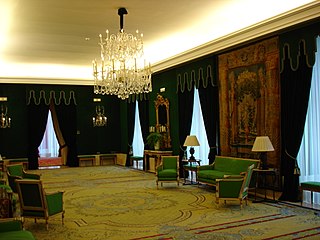 W
WIn show business, the green room is the space in a theatre or similar venue that functions as a waiting room and lounge for performers before, during, and after a performance or show when they are not engaged on stage. Green rooms typically have seating for the performers, such as upholstered chairs and sofas.
 W
WA marquee is most commonly a structure placed over the entrance to a hotel, theatre, casino, train station, or similar building. It often has signage stating either the name of the establishment or, in the case of theatres, the play or movie and the artist(s) appearing at that venue. The marquee is sometimes identifiable by a surrounding cache of light bulbs, usually yellow or white, that flash intermittently or as chasing lights.
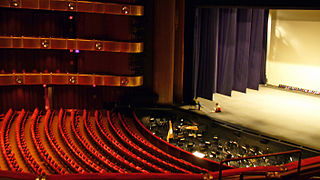 W
WAn orchestra pit is the area in a theater in which musicians perform. Orchestral pits are utilized in forms of theatre that require music or in cases when incidental music is required. The conductor is typically positioned at the front of the orchestral pit facing the stage.
 W
WThe word passerelle is a French word that means "footbridge" or "gangway." In the theatre, it refers to a small catwalk that extends from one side of the stage to the other, passing in front of the orchestra pit. Besides increasing the total stage area, this stage design allows performers to be closer to the audience.
 W
WIn a theatre, the prompt corner or prompt box is the place where the prompter—usually the stage manager in the US or deputy stage manager in the UK—stands in order to coordinate the performance and to remind performers of their lines when required. It is traditionally located at stage left.
 W
WA proscenium is the metaphorical vertical plane of space in a theatre, usually surrounded on the top and sides by a physical proscenium arch and on the bottom by the stage floor itself, which serves as the frame into which the audience observes from a more or less unified angle the events taking place upon the stage during a theatrical performance. The concept of the fourth wall of the theatre stage space that faces the audience is essentially the same.
 W
WA rake or raked stage is a theatre stage that slopes upwards, away from the audience. Such a design was typical of English theatre in the Middle Ages and early Modern era, and improves the view and sound for spectators. It also helps with the illusion of perspective: when features of the scenery are made to align with a notional vanishing point beyond the rear of the stage, the rake supports the illusion. These elements of scenery are termed raking pieces.
 W
WA revolving auditorium is a mechanically controlled seating area within a theatre which can be rotated in order to manipulate the change of scenery and stage sets during the performance. Revolving auditoriums are favoured by open-air theatres in particular, because they are ideally suited for the use of natural scenery as an integral part of the set.
 W
WA safety curtain is a fire safety precaution used in large proscenium theatres. It is usually a heavy fibreglass or iron curtain located immediately behind the proscenium arch. Asbestos-based materials were originally used to manufacture the curtain, before the dangers of asbestos were widely known. The safety curtain is sometimes referred to as an iron in British theatres, regardless of the actual construction material.
 W
WA scenery shop or scene shop is a specialized workshop found in many medium or large theaters, as well as many educational theatre settings. The primary function of a scene shop is to fabricate and assemble the flats, platforms, scenery wagons, and other scenic (set) pieces required for a performance. Commonly, a scene shop is also the location where most of the set painting is done, and is sometimes used to make props. Generally, the individuals who work in a scene shop are carpenters, although, in bigger shops, it is common for metalworkers to be employed for steel-construction set pieces which require welding and other machining. It is common for the individuals working in a scene shop to be knowledgeable in a wide variety of technical skills, developed over time as required for specific construction needs.
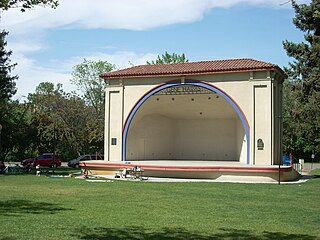 W
WIn theater, a shell is a curved, hard surface designed to reflect sound towards an audience.
 W
WIn the theatre of ancient Greece, the skene was the structure at the back of a stage. The word skene means "tent" or "hut", and it is thought that the original structure for these purposes was a tent or light building of wood and was a temporary structure. It was initially a very light structure or just cloth hanging from a rope, but over the course of time the skene underwent fundamental changes. First, it became a permanent building, whose roof could sometimes be used to make speeches, and as time passed it was raised up from the level of the orchestra, creating a proskenion, or "space in front of the skene". The facade of the proskenion was behind the orchestra and provided a space for supporting stage scenery.
 W
WIn theatre and performing arts, the stage is a designated space for the performance of productions. The stage serves as a space for actors or performers and a focal point for the audience. As an architectural feature, the stage may consist of a platform or series of platforms. In some cases, these may be temporary or adjustable but in theaters and other buildings devoted to such productions, the stage is often a permanent feature.
 W
WStand-up comedy is a comedy performance and narrative craft whereby a comedian communicates to a live audience, speaking directly to them through a microphone. The performer is commonly known as a comic, stand-up comic, comedian, comedienne, stand-up comedian, or simply a stand-up. Stand-up comedy is a dialogic monologue, or a grouping of humorous stories, jokes, and one-liners, typically called a shtick, routine, act, or set. Stand-ups may fuse props, music, magic tricks, or ventriloquism. Stand-up comedians perform quasi-autobiographical and fictionalized extensions of their offstage selves.
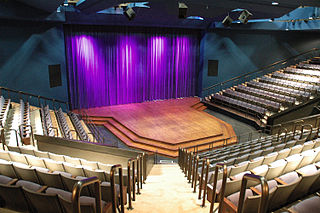 W
WIn theatre, a thrust stage is one that extends into the audience on three sides and is connected to the backstage area by its upstage end. A thrust has the benefit of greater intimacy between performers and the audience than a proscenium, while retaining the utility of a backstage area. Entrances onto a thrust are most readily made from backstage, although some theatres provide for performers to enter through the audience using vomitory entrances. A theatre in the round, exposed on all sides to the audience, is without a backstage and relies entirely on entrances in the auditorium or from under the stage.
 W
WThe trapdoor is a sliding or hinged door in the floor or ceiling. It is traditionally small in size. It was invented to facilitate the hoisting of grain up through mills, however, its list of uses has grown over time. The trapdoor has played a pivotal function in the operation of the gallows, cargo ships, trains and more recently theatre and films.
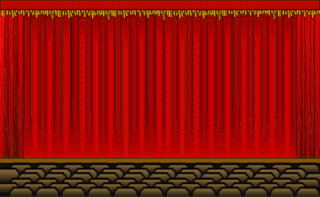 W
WA traveler curtain, also called draw curtain, bi-parting curtain, or just traveler, is the most common type of front curtain used in theaters. Traveler curtains remain at a fixed elevation and open and close horizontally, break up and meet in the middle, and consequently require a minimum of fly space. The curtains are typically made of velvet and decorated with a series of vertical box pleats along the top edge.
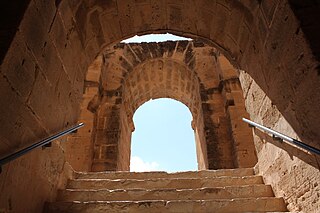 W
WA vomitorium is a passage situated below or behind a tier of seats in an amphitheatre or a stadium, through which big crowds can exit rapidly at the end of a performance. They can also be pathways for actors to enter and leave stage. The Latin word vomitorium, plural vomitoria, derives from the verb vomō, vomere, "to spew forth". In ancient Roman architecture, vomitoria were designed to provide rapid egress for large crowds at amphitheatres and stadia, as they do in modern sports stadia and large theatres.